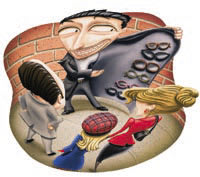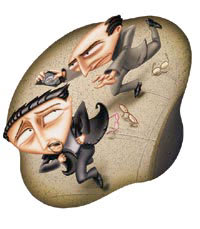Knock Off the Knock-offs! What the industry is doing to combat counterfeit frames By Marcy Bruch Illustrations by Marty Roper They're everywhere. On the streets of NewYork City. At flea markets. Along the New Jersey Turnpike. At pushcarts in malls across America. They're counterfeit sunglass frames. Bill Thomas, CEO and executive vice president of Vision Council of America (VCA), estimates these frame knock-offs rob optical retailers of four to seven percent of their designer brand sunglass sales. In a flat market, increasing sales by four to seven percent equates to a healthy boost in business. That means combatting counterfeit frames is a worthy battle for optical retailers to take on. And while many admit they have never gauged the impact fake frames have on business, Barry Franzblau, owner of two Couture Optique stores in Florida, points out: "For every counterfeit frame that's sold, that's one more lost sale to a legitimate retailer. Consider the volume of business peddlers do at rest stops on the turnpike alone and you realize it really adds up." But counterfeit eyewear causes other damage that is less quantifiable, too. It tarnishes the integrity of the brand it copies. Which is why many eyewear manufacturers are uniting to take arms against this sea of fakes. But like other undercover wars, doing battle isn't easy. That's why the VCA membership formed an anti-counterfeiting task force in 1999 to wage the war more effectively. The task force includes: Al Berg, Marchon; Claudio Gottardi, S�filo; Michael Boxer, Luxottica; Harvey Ross, Viva; Frank Rescigna, Marcolin; and Mike Hundert, Rem. Al Berg, who is the chairperson of the task force, explains what they're up against: "I hate to make the analogy, but I compare our anti-counterfeiting efforts to the war on drugs. And the best way we can win is by pooling our resources."
Get To the Source Timothy Trainer, president of the IACC, reports that in 1999, the coalition confiscated 1.5 million counterfeit eyewear pieces with an approximate value worth $18.3 million in wholesale dollars. Most of the confiscating took place in distribution warehouses and at U.S. customs. The IACC got court orders for 1,100 civil seizures to shut down operations that warehoused counterfeit eyewear in the United States, and made 550 personal criminal arrests. "While it's nice to do a street sweep, the real goal is to get at the people behind this," says Trainer. Thomas agrees. "Stopping a vendor from selling counterfeit product on the street is like spitting into the wind," he says. Which is why much of the IACC's focus takes place overseas, particularly in Asia, where the counterfeit product is manufactured. "We examine foreign law and work with foreign officials to get them to cooperate," says Trainer. "But you need to go through an incredible amount of red tape before you can bust a factory that is manufacturing counterfeit product," he admits. Claudio Gottardi of S�filo, a member of the VCA task force, agrees. "The rules and laws of the countries where this product is produced are very defensive, and the legal implications are sticky. There are different laws in each country. So the only way you can begin to address the problem is to have a local presence in these countries to help you interpret the law." In the meantime, much of the IACC efforts have been to educate customs officials to identify counterfeit eyewear so they can confiscate it at U.S. points of entry. Since the biggest problem areas for counterfeit smuggling are in California, Miami, New York City, and along the Texas/Mexico border, IACC recently sent training teams to these areas to educate customs officials on how to differentiate between counterfeit sunwear and the original brand name product. "There are actually two kinds of counterfeiting that takes place," explains Trainer. "One is when a product features an exact replica of a trademark logo, and that is considered a criminal penalty. The other kind of counterfeiting is when the logo mark may not be identical to the original, but still causes confusion to the consumer." Trainer admits that there are some gaps in the law that prevent the IACC from doing much about curtailing eyewear that has nebulous logos. "We're working with federal legislators to rewrite the current law that protects famous marks in order to tighten up provisions. That would address counterfeiters that slightly alter trademarks," he says.
A Happy Problem? The irony is that the more a particular sunwear style is counterfeited, the more it verifies a brand's popularity. So in a sense, it's a happy problem to have. "It's a byproduct of success," Gottardi admits. To prove the point, it's only S�filo's best-selling Gucci styles that are copied and sold on the street. The most prevalent brands that are counterfeited include: Gucci, Oakley, Giorgio Armani, Dolce & Gabbana, Calvin Klein, Ray-Ban, Guess?, and Versace. Oakley has been particularly aggressive about tracking down fake product. "Counterfeiters are not only stealing from us by copying our innovations, they're undermining our brand," asserts Vance Lommen, director of legal security for Oakley. And since counterfeiting is a pet peeve of Oakley's CEO, Jim Jannard, Lommen says the company will do whatever it takes to protect the Oakley name. That's why Lommen leads five full-time staffers who do nothing but track down Oakley counterfeits. In addition, Oakley employs 150 private investigators worldwide that concentrate their efforts in Asia and Europe. "Thanks to one of our investigators, we recently confiscated 80,000 units out of Paris," he says. On the domestic front, Lommen recently met with the police commissioner of New York City to discuss how to crack down on counterfeit eyewear sold on Canal Street. "Oakley believes it's well worth it to do a street sweep." "We have zero tolerance for counterfeiting. So if we hit the guys on the streets in their pocketbook where it hurts, maybe they'll get tired of getting busted and stop. What's more, we don't want to see this fake stuff getting mailed to us when it breaks a week later. Plus, it's a hazard to public safety because the product claims to offer 100 percent UV protection and it doesn't. So it's embarrassing all the way around," Lommen points out. To streamline its anti-counterfeiting efforts, Oakley has a hotline that anyone can call to report counterfeit sightings. Oakley's Swat Team Lommen adds, "When we get a call, we send out a task force to crush them immediately," At press time, Oakley was poised to do a raid in Los Angeles of a counterfeit shipment due in from China. Other recent busts include the raid of a Los Angeles manufacturing plant and a major confiscation in El Paso, Texas. But Oakley is not the only company that has expended enormous resources in the war against counterfeit product. Gottardi of S�filo estimates that his company spends about $2 million a year in legal expenses to combat counterfeiting. He believes that S�filo probably loses about two to four percent of its sales due to counterfeit sales. Yet he is quick to point out another loss that is less quantifiable, which is how the counterfeit product undermines a brand's image. "When consumers see a knock-off on the street, they may think twice about paying a premium price for the original because they reason that no one would know the difference between the counterfeit and original anyway. And that translates to additional lost sales," Gottardi says. "So we lose sales for two reasons. And the sum of these two reasons impacts the company by about five to 10 percent in lost sales due to counterfeiters."
While it is true that counterfeiting mostly impacts the major eyewear companies that hold the megabrands, there is a related issue that impacts every manufacturer, which is the diversion of product-otherwise known as gray market goods. This deals with a product's country of origin and how the product is marked. "Many companies produce their eyewear in Asia then ship it to Europe where it is marked 'Made in Italy,' or 'Made in France,'" says Harvey Ross of Viva. "That mark will automatically command a higher retail price because the consumer has the perception that eyewear made in Europe is of better quality than product made in Asia, even though that's not always true. We need some kind of quality control regarding country of origin marks to level the playing field in our industry," Ross asserts. S�filo has gone so far as to apply ghost marks to frames that can only be seen with ultraviolet light. "Each mark is different, so once we read the code we can retrace how the product was diverted," explains Gottardi. He believes that both product diversion and counterfeit product can be curtailed, but eliminating the problems seems virtually impossible. Berg of Marchon is more optimistic. As the leader of VCA's anti-counterfeit task force, he has a rallying cry: "We must strengthen the front lines by uniting and pooling our resources. This will increase our efficiency, reduce our expenses, and enhance results. That's how the federal government began beating the Colombian drug lords." He adds, "My job is to acquire better brands to make more sales. Counterfeiters get in the way of those efforts. That's why I have to intercept counterfeiters to protect the assets of our brands." At Marchon, Berg says that counterfeiting appears primarily in cK but there has been counterfeiting in Donna Karan and Fendi, too. "More often than not, it's a signature piece in a collection," he says. Both Gottardi and Berg point out that because of the advancement in technology at production factories, it will become harder to distinguish fakes from the originals in the future. "If the consumer loses confidence in whether his purchase is indeed an original, then brand value will be diminished even more," Berg warns. "That's why the biggest challenge for us is the cost of enforcement. We need to gather evidence that is compelling enough to bring government agencies to action. The industry must take a stand not only verbally, but financially," maintains Berg.
The Internet: New Frontier for Counterfeiting The VCA's anti-counterfeiting task force recently hired Frederic Grethel, special consultant to the VCA frame division, to help spearhead its efforts. "On the drawing board is the purchase of software featuring a Web crawler that would search the Internet for counterfeit product," says Grethel. "And we're developing a master database of information on counterfeiting that can be shared with the IACC." One of the issues that has prevented the task force from going forward is the cost of pursuing counterfeiters. "Since it is only a problem among selected manufacturers, some members don't want their membership money to go toward a cause that is not their problem," explains Mike Hundert of Rem. "But I am all for the protection of intellectual property. Because it may not be my problem today, but it could be my problem tomorrow." In the meantime, optical retailers would be wise to remind their customers that counterfeit eyewear is nothing more than fakes that break from peddlers who push for profit. And they can tell people to handle the situation the same way they would deal with any other hustler who's trying to sell something illegal on the streets. Just say no. EB
|
Article
Knock Off the Knock-offs!
What the industry is doing to combat counterfeit frames
Eyecare Business
February 1, 2001








